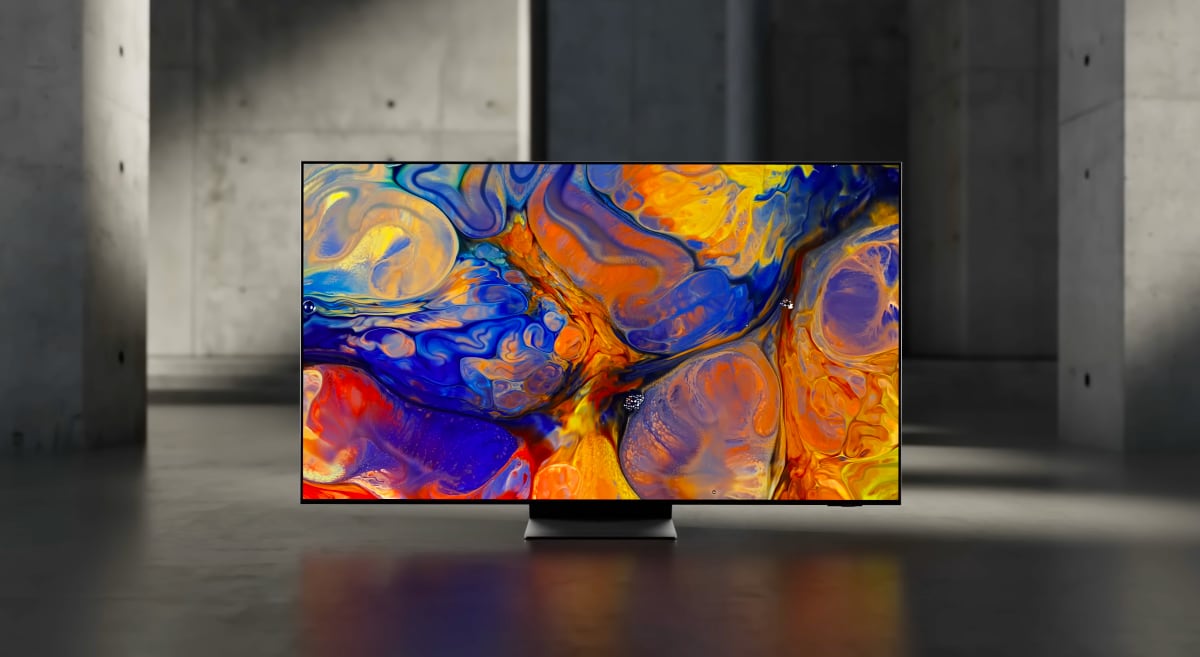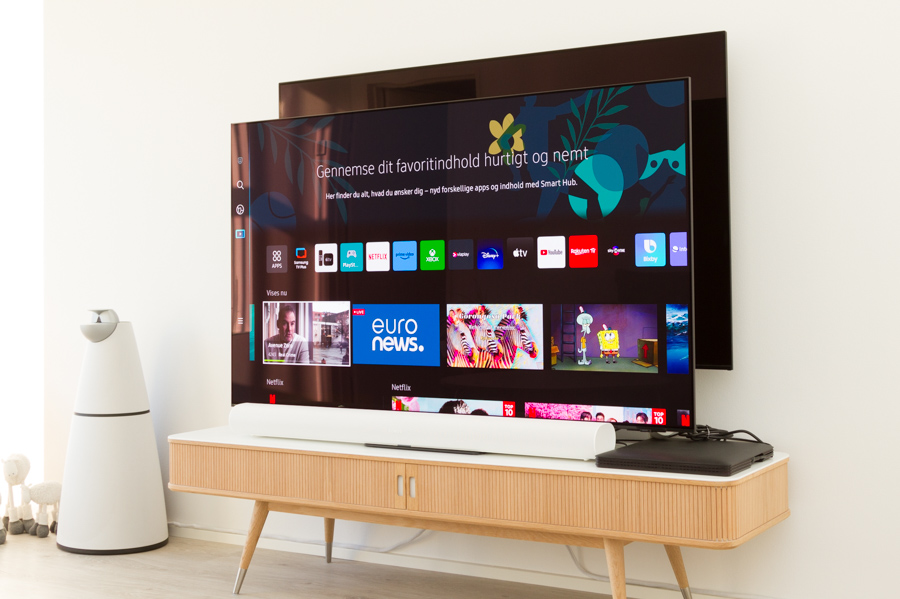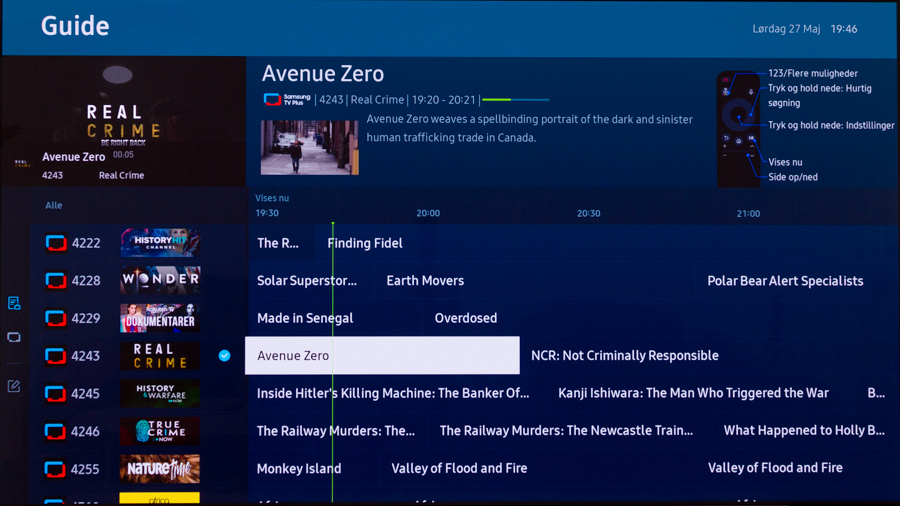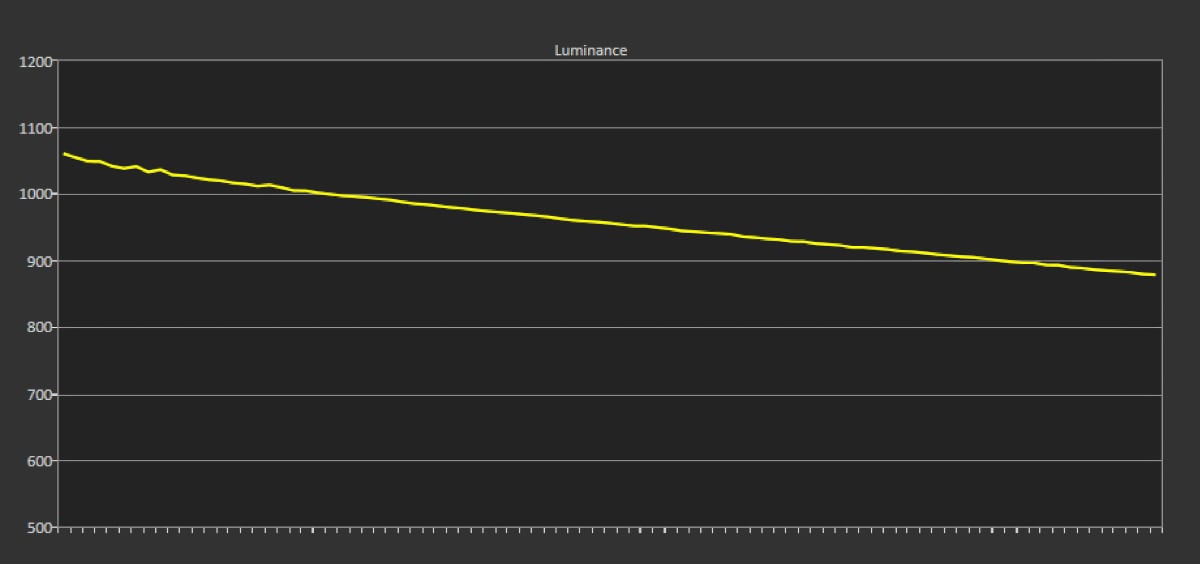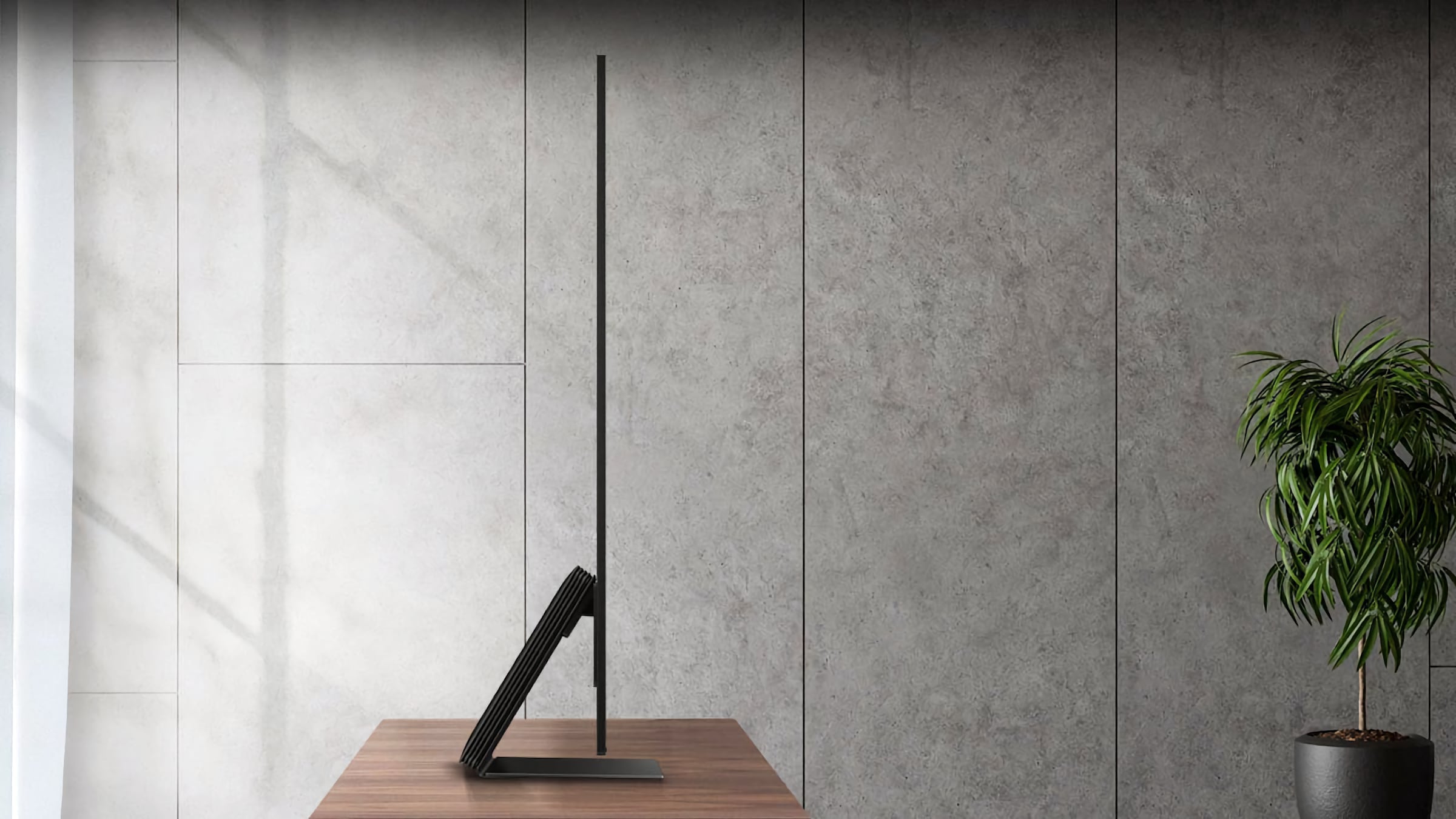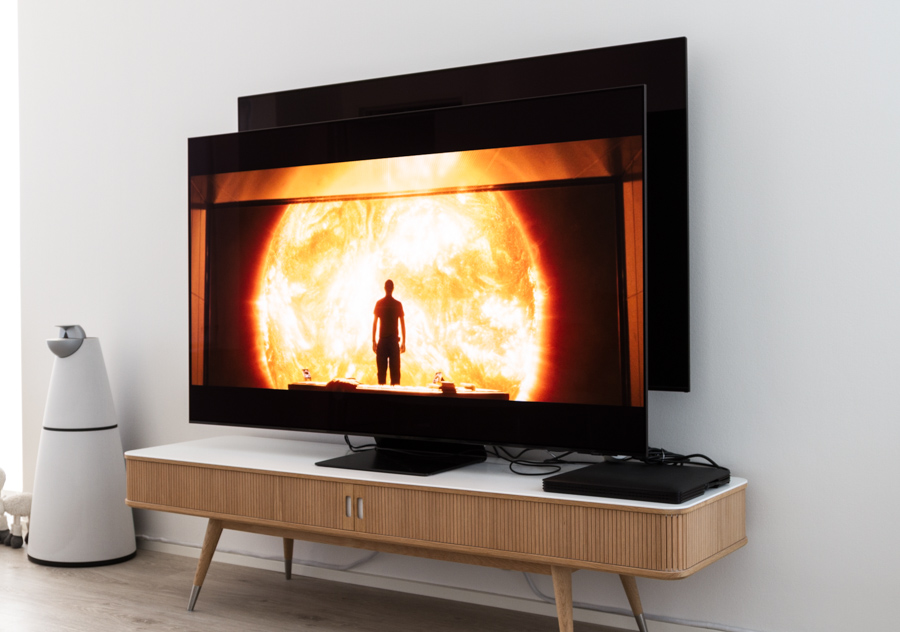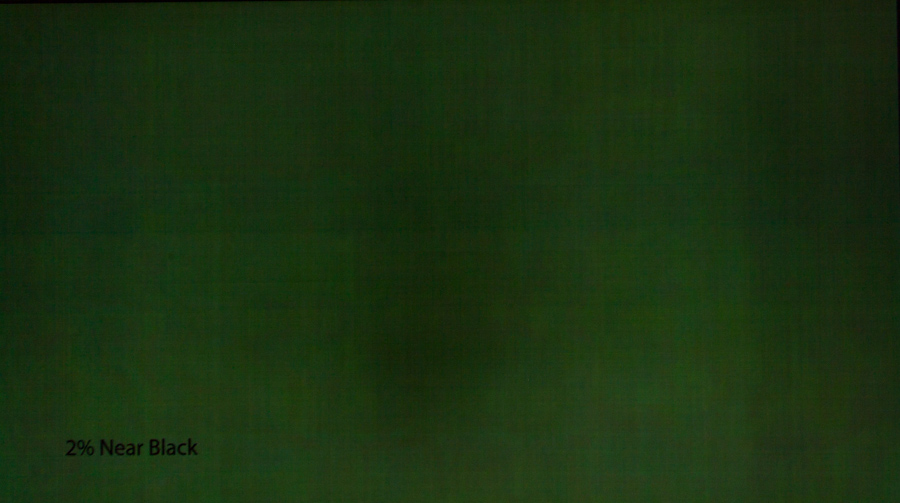Review: Samsung S95C QD-OLED
We didn't get the chance to look at Samsung's QD-OLED TV last year but did examine the new QD-OLED panel type on a Sony model instead. This year we have gotten our hands on the updated version of Samsung's S95 series, namely the S95C, which promises higher brightness than last year, the external One Connect box, and a few other new features. S95C is available in 55 to 77 inches. We have reviewed the 65-inch. Also read: Samsung 2023 TV line-upPrice and retailers:
First impressions
OLED makers have traditionally emphasized very thin TVs – at least in the area of the TV where there is no electronics bix. However, the Samsung S95C takes it up a notch by moving all electronics into the external One Connect box. We first saw the redesigned One Connect box on the Samsung QN95B last year, and now it has become part of S95C as well. The result is a TV with OLED thinness throughout the screen, making it approximately the same thickness everywhere as a standard smartphone. Unlike LG's previous 'Wallpaper' models, you can still handle S95C without risking breaking the panel – which is a must because mounting the tabletop stand requires the TV to be laid flat on a table, as the TV is not placed "down" into the stand, but the stand is inserted into the back of the TV, just like on the QN95B. Unfortunately, the experience of mounting the tabletop stand is among the worst I have encountered. It's not an optimal solution and a bit unfortunate when the overall finish is top-notch. If we take a look at the back, S95C closely resembles the QN95B with its centrally placed One Connect cable, six speaker units, and completely flat back. If one were to criticize the look, one negative is that for wall mounting there is no cable channel for the thick One Connect cable. So even though all connections to the TV – including power and inputs – are routed through this single cable from the One Connect box to the TV, you still have to get the thickness of the cable past the back of the TV. As a result, you will not have the TV completely flush to the wall. Samsung's own slim bracket still leaves a few millimeters of space. It's a minor detail. The One Connect box allows you to place the box a few meters away from the TV such as in a piece of furniture or similar, or you can place it on the back of the stand. The box still has a considerable size although not as thick as some of the previous models. The box's dimensions may be an advantage for some but certainly a disadvantage for others. You will probably find it as hard to hide as finding space for a PS5 in your TV rack – they have approximately the same footprint. Be aware that the box contains the power supply for the TV, so it will generate a fair amount of heat. During the review, the box was placed on top of furniture, and there was no audible noise from the built-in fan – just a slight whispering sound. However, if you enclose it that might change. Reflections in S95C's screen are of the same type as Sony's A95K but with a slightly more reddish character. If you are familiar with OLED technology this is not significantly different. Samsung has used its more effective anti-reflection coating from the high-end LCD models on its 2023 QD-OLED TVs but as we have uncovered in other reviews, this coating also comes with certain drawbacks.User experience & features
Last year, Samsung redesigned Tizen to a fullscreen user interface, radically changing the appearance and the way users interact with apps. In our review of QN95B last year, we covered most of the changes and the overall appearance hasn't changed in 2023. The following is a brief overview of Tizen 7.0 with a focus on what's new. TV set-up can be done either via a smartphone or the remote control. If you have ever owned a Samsung TV, you should know that it is relatively easy to go through the setup process using a phone. Unfortunately, there is still no ability to log in to all apps in one swoop but this is unlikely to change in the near future, as it would require storing of third-party login and password credentials in Samsung's cloud. Looking at Samsung's product pages online, there is not much on Tizen in general. However, as mentioned above, the appearance has changed since 2021 shifting from being a menu bar discreetly placed at the bottom of the screen to a full-screen UI allowing for much more content to be shown – for better or worse. Both Google and LG have moved in the same direction with Google TV and webOS, respectively, and even Apple TV has a homescreen in full screen. While the Tizen redesign provides quick access to all apps, it also opens up the possibility of squeezing in more ads. You, as the user, have the ability to tweak a few things on the homescreen, primarily in the top row of apps where you can add shortcuts to your favorite apps and input sources. Personally, I don't find the new layout more user-friendly than the 2021 version but compared to Android TV / Google TV and webOS, it might be just a different version of "annoying", a perhaps mostly a matter of personal preference. The placement of content relates to how you have arranged apps in the row at the top. Samsung's "Gaming Hub" is available only in select regions but gaming apps such as GeForce Now and Xbox are still available separately from the app store in non-supported regions. The 'Media Hub' and 'Ambient Hub' are available in all regions. The Ambient Hub allows you to use the TV as a sort of photo slideshow by downloading various types of "art" from Samsung's portal. However, since the TV lacks the full photo frame functionality of Samsung's The Frame models the feature feels more or less as irrelevant as it does on LG, Panasonic, and Philips' models. Using it in daily life simply requires too many button presses and the Ambient Mode doesn't start automatically so it never provides a seamless experience.Samsung TV PlusSamsung's Media Hub provides access to content from various streaming services, and partners seem to be able to purchase prominent placement within the interface. One of the services that is prominently featured is Samsung's own TV Plus service, which provides access to several free tv-channels with ads. These channels range from dedicated channels with 24-hour broadcasts of shows like SpongeBob SquarePants or Robot Wars to news channels, nature channels, documentaries, music, movies, and certain sports events (not big events). The picture quality of the TV channels is not great but as a Samsung buyer you have free access to them if you can accept the ad load. There is a TV guide, too. It doesn't require a subscription to access. Taking a look at the user interface related to the actual TV – not Tizen – some menus may feel like a graphical step backwards while others are more or less identical to previous years. The TV Guide and channels menu are tweaked from last year's models, but since they are functional and pleasant to look at, most users should be satisfied. It is possible to customize which setting options are shown in the quick access menu at the bottom but unfortunately there not all settings options can be placed here. In the same vein, Samsung's Gaming menu that can be activated when a game is running lets you quickly access certain picture settings that can provide advantages in games such as adding a crosshair on the screen or boosting shadow details. However, be aware that such picture adjustments will alter the picture quality. A recent addition is the Xbox app that with an Xbox Game Pass Ultimate subscription provides access to cloud gaming directly on the TV without the need for an external game console. We paired an Xbox controller in the Xbox app and logged into our Xbox Game Pass Ultimate account, which gave us direct access to the games that Microsoft and partners have prepared for cloud streaming. It is highly recommended to have a fast and stable internet connection to ensure the best experience, but even with a 1 Gbps fiber connection connected to the TV via Ethernet our experience with the Xbox app was mediocre. The biggest hurdle, I would say, is input lag meaning the delay between input from the controller to the reaction on the screen, which was too high and therefore significantly affected the gaming experience. Additionally, there were random lags in games and the frame rate was too low to provide a satisfactory experience. Some games were playable but fast-paced games like Halo, Forza Horizon or Deathloop were not playable due to the delay and poor frame rate. Add to that the fact that the resolution is lower than what one may be accustomed to from dedicated game console and you often end up in a situation where it feels more of a gimmick than a viable alternative to a real console. On a positive note, S95C automatically detected streamed Xbox games and activated Game mode. S95C's ultra-thin design naturally leaves very little space for speakers but similar to the QN95B there are still four bass units located at the back of the TV, as well as up-firing and side-firing units to enhance Dolby Atmos sound. Listening to S95C, it's clear that the bass units are not very powerful so film enthusiasts will long for more but voices are generally clear, making it an acceptable solution for mixed viewing. Support for Dolby Atmos and the addition of a few small additional units to enhance sound dispersion in the room is not enough to provide a cinematic experience. They lack the punch and power needed for immersion and rich sound experiences. As with most other TVs on the market, we recommend a separate sound system. As usual, we tested the TV with a Sonos Arc soundbar which naturally provided a better listening experience. We encountered no issues with CEC and eARC in Samsung S95C and it correctly passed Atmos sound through the TV. Unfortunately, with an external soundbar there is no volume indicators on the screen – like in Sony's TVs – but there is a generic indication that you are adjusting volume. If you plan to connect a more powerful surround system to S95C, be aware that it lacks support for DTS support. Samsing's remote control is one of the most minimalist out there, housing only the most basic (and necessary) buttons. The volume and program buttons have multiple functions and can be clicked, pushed or held down to access additional features. Anything not found on the remote can be accessed through the settings wheel button which opens an additional on-screen menu. It would have been nice to have a shortcut for input sources but the home menu will always take you to the selection of apps and inputs if you remember to add favorites to the homescreen's list. The four sponsored app buttons on the remote control are fortunately placed relatively inconspicuously at the bottom so you don't press them accidentally. However, it would be a miracle if those four happened to be your favorite apps, highlighting why it is hopeless to waste buttons on specific services. Unfortunately, the choice of material on the remote control is plain plastic and it doesn't feel particularly high-end or luxurious to use. The light weight of the remote doesn't help with this impression either. On the other hand the buttons themselves feel good to press and the small solar panel on the back can reportedly keep the remote running without the need to connect a USB-C charger, according to Samsung. Personally, I still miss the incredibly sleek version we first saw back in 2017 so I'd like to make a plea to Samsung to bring back the metal version, especially considering that S95C is a premium model.Calibration
Samsung has fewer picture modes than most other TV makers and there are good option for fine-tuning, too. As usual, the default picture modes are quite terrible. Samsung is luckily on board with the Filmmaker initiative so this should be your go-to picture mode. Samsung TVs do still not support Dolby Vision. There is support for Samsung's own HDR10+ but unfortunately the market has not fully embraced this standard, although services like Apple are starting to add content in both Dolby Vision and HDR10+. In real use, it means that most of the time you will not get HDR content with dynamic metadata, which is a shame. While Dolby Vision is not a guarantee for quality, it does open up certain possibilities for setting, for example, peak brightness on a scene-by-scene basis. Like most other TVs, Samsung has a setting option to apply dynamic tone-mapping to HDR content, which theoretically can help mitigate the issue outlined above. However, partly due to the missing signal information and partly due to Samsung's choices you often end up with HDR pictures that are too bright, with both shadow details and highlights boosted too much. We recommend using static tone-mapping instead. Some tweaking of the white balance was required to achieve the reference picture – it can be done using 2-point adjustment. The issue reported last year where Samsung's TVs recognized test patterns and changed picture characteristics to appear accurate but later boosted color/luminance outside calibration situations, was not observed this year with S95C. Samsung has seemingly fixed the firmware so that the correct gamma/PQ curve is maintained regardless of the source, but you can never know what will happen in future firmware updates. Samsung's QD-OLED panel is characterized by the fact that there is no need to mix white light into primary and secondary colors to achieve high HDR luminance, which provides purer colors in highlights and an overall higher color volume. Our measurements on S95C fall largely in line with those from last year's Sony A95K but the core blue subpixel can reach higher luminance (+23% in our measurement) which enables higher overall brightness. The color gamut is also significantly closer to rec.2020 than what LG's WOLED panels can achieve. In terms of peak brightness, Samsung's 2023 S95C surpasses Sony's 2022 A95K with a peak of over 1200 nits (momentary). In our measurement sessions this brightness could only be achieved if we gave the QD-OLED panel a break from time to time. Under more stress, peak brightness would typically reach approximately 1050 nits.Other picture modes
Click the title to expand the view
Movie (SDR) Filmmaker (SDR) Dynamic (SDR) Standard (HDR) Movie (HDR) Dynamic (HDR) Y axis: Brightness (nits). X axis: Time. Brightness falls over time with static contentAs seen in the graph above, HDR peak brightness falls over time with static content on the screen, which in our test was the same white square that we use for measurements.Measurements
In our "measurements" section we include all measurements and our suggested calibration settings. If you want to learn more about our test methodology click here. Note: Starting in 2021, we implemented a new method for measurement of average power consumption in SDR and HDR, meaning that earlier measurements are not 1:1 comparable. Power consumption in 'Calibrated' SDR mode is measured with the screen to approx. 100-120 nits to normalize the measurement across TV models (our recommended calibrated picture settings may differ). The new method will be used in all TV reviews going forward.Note: We include calibration settings only for SDR, not HDR. For our calibration we have deactivated the ambient light sensor that automatically adjusts the backlight setting according to your environment. You may prefer to have it enabled.Picture quality
Samsung's introduction of QD-OLED display technology last year paved the way for a more intense and accurate HDR viewing experience as it is using pure primary colors without the use of color filters, and the absence of white light mixed into highlights creates more vibrant colors. This difference won't be noticeable if your primary source of content is still SDR, so let's instead focus on S95C's HDR picture quality. S95C delivers impressive brightness, not only in whites but also in primary and secondary colors. This allows for stunning HDR reproduction where peak brightness is of course most evident in intense highlights such as light sources and explosions. The pure white color consistently reaches around 200 nits higher than our reference TV from 2022, Sony A95K, while primary and secondary colors perform similarly, which is still ahead of WOLED models. When reaching around 1000 nits, the difference between 1100 and 900 nits on pure white doesn't make a significant impact, but when all other colors are twice as bright as on a "traditional" WOLED, there are certain scenes where the difference becomes noticeable. Scenes with red and yellow highlights such as explosions and fire really showcase the capabilities of the 2023 QD-OLED panel in S95C. The desert scene from Mad Max: Fury Road is a great example, where the color spectrum is vividly displayed, allowing S95C to shine. The same can be said for Bilbo and the dwarves' battle against Smaug in The Hobbit, where you can almost feel the flames in your living room. If you're a first-time QD-OLED buyer, it's worth treating yourself to these types of scenes first on your old TV and then on QD-OLED! Another improvement is that the 2023 QD-OLED panel in Samsung S95C delivers almost 30% higher fullscreen (100% window) brightness than the 2022 QD-OLED panel in Sony A95K, according to our measurements as seen in the 'Measurement' section. We measured our 65-inch S95C to 240 nits in full-screen, making it even more capable in general in bright rooms and a little more capable in those rare HDR scenes that require high brightness in a larger portion of the picture (see our measurements on 75%, 50% and 25% windows, too). As mentioned earlier, Samsung lacks Dolby Vision support and has instead pushed its own HDR10+ as the dynamic metadata format. There are relatively few sources available with support for HDR10+ but their numbers are slowly increasing. It's a shame that we can't have Dolby Vision included too since there's potential in being able to define peak brightness more precisely with scene-by-scene metadata. It's impossible to demonstrate the differences between two screens without also having the Sony A95K, the only QD-OLED model with Dolby Vision support, standing next to it. However, a specific example is the way subtitles are handled from devices like the Apple TV box, where they were generally harder to read on the S95C. The visible differences between screens will also depend largely on how filmmakers have handled HDR10 and Dolby Vision in their content, so results can vary. Samsung's MotionPlus system for motion smoothing is slightly behind Sony's and LG's and more on par with Panasonic's. The commonality between the two is that they occasionally exhibit artifacts in the picture with the system engaged. While we generally advocate for avoiding video processing that alters the intended look of the content, it can be desirable to apply a little motion smoothing to an OLED display due its ultra-fast response time, which can result in an unfortunate stroboscopic effect in very bright scenes, especially with material shot at low frame rates like 24 frames per second (fps) – practically all movies and series. No TVs on the market currently deliver motion smoothing without side effects, but Sony still leads with their MotionFlow on low settings. In the end, I ended up disabling the system entirely on Samsung S95C to just accept the stutter that occurs with 24fps content. Handling of compressed material is also slightly below performance on Panasonic, Sony, and LG's high-end TVs. Especially Sony's Smooth Gradation manages to better smoothen out problematic gradients from heavily compressed video. One significant area where QD-OLED differs substantially from WOLED is in pixel structure. Allow me to copy the text from last year's A95K review: In addition to a change in how colors are created and derived, Samsung has changed the pixel structure. In WOLED there are four WRGB subpixels (white booster plus red, green, blue). QD-OLED is a more traditional RGB-like sandwich but instead of an RGB stribe layout Samsung Display has arranged the three subpixels in a triangle, as seen below, where the green subpixel is placed on its own row and takes up a little more space than the other two subpixels. FlatpanelsHD asked Samsung Display to comment on its decision for triangular pixels. You can find Samsung Display's response here here. On the 55-inch QD-OLED TV that we tested last year (Sony A95K) I did not always notice the color fringing artifacts around contrast-rich objects in the picture, but on the 65-inch S95C it is easier to spot the artifacts from a normal seating distance of 3 meters to the sofa. The types of objects that highlight the issue do not occur very often in movies, but text elements often exhibit the phenomenon, and it can be distracting. The display should not be considered for use as a monitor. There's also a risk of running into the issue quite often in gaming due to the presence of on-screen text and HUDs. Last year, we criticized QD-OLED for its sensitivity to ambient light, where the quantum-dot layer on the screen had a tendency to be affected by external light so that the QD-OLED TV became unable to display true black in well-lit rooms. The issue remains in 2023, but among the few flaws the technology suffers from, this may be the least prominent during testing. One may notice what we can call a "raised black level" in certain situations, but often it occurs when there is already ambient light in the room that can affect the image through reflections, so you have to concentrate to see it. Unlike blooming on LCD panels in a dark room, which is highly detrimental to picture quality, the QD-OLED black issue is not observed in a dark room, so it shouldn't be a factor that discourages you from buying a QD-OLED panel. Looking at panel uniformity of black/gray in dark surroundings, there is a slight tendency for the center of the screen to appear darker than the sides, but we are dealing with a sample of one. The problem on QD-OLED seems to be theoretical in nature, so it's not something to be concerned about. Going forward, we will focus less on describing TV models that do not have issues and instead emphasize those that do have problems. Below are photos of 2 IRE (very dark gray) captured with an ultra-long exposure time, which illustrates my point – it requires unrealistic conditions to spot issues. Samsung S95C is well-equipped to handle your favorite gaming source, and in addition to the previously mentioned Gamebar menu, it features four HDMI 2.1 inputs that support 4K 120Hz and a wide range of VRR (Variable Refresh Rate) technologies, including VRR, G-Sync Compatible, and FreeSync. It can even go as high as 144 Hz for the input frequency with a compatible PC. Regarding HDMI 2.1 features, QMS (Quick Media Switching), which was recently added to LG's 2023 models, is still missing, but S95C's overall support for external hardware is difficult to fault. As mentioned before, our measuring equipment does not work with VRR, so we cannot measure the lowest possible input lag. On most TVs, we are now reaching a point where the numerical value of the measurement is not particularly relevant. Similar to evaluating panel uniformity, in the future, we will likely focus on mentioning if something stands out in an unfavorable direction rather than focusing on what most TVs already handle well. We achieve under 10 ms in game mode on S95C, and according to Rtings this number can be halved with VRR.Conclusion
S95C is Samsung's 4K flagship model for 2023 and it has a lot to offer. Compared to last year's S95B, S95C has been upgraded with the external One Connect box, which has a flatter profile that can be clipped onto the tabletop stand or hidden away in a cabinet. The design is ultra-minimalistic and sleek, and the only design-related criticism we have is the plastic remote control, which doesn't quite match the overall look of the TV.Ad:S95C is built around the acclaimed QD-OLED panel, which again in 2023 offers an expanded color space, even higher peak brightness, and color accuracy that can easily compete with the flagship models from Sony and LG. Samsung's picture algorithms are slightly behind our reference model from Sony or LG's flagship models, but you have to scrutinize it to notice the difference. However, like Sony's A95K, you must be aware of the special pixel structure, which results in color fringing in high-contrast color transitions; the effect becomes more noticeable the larger the screen you buy. Avoid buying QD-OLED for text-heavy tasks. Samsung's Tizen interface has adopted the trend of going full-screen, which provides a better overview but unfortunately also allows for more promoted content to be squeezed into the field of view. We are not convinced of the qualities of full-screen Tizen, but it is a trend that most have adopted at this point. Last year, we observed how Samsung S95B quickly reached a price level that made it highly competitive against WOLED. This year, starting prices have been raised and for now S95C does not compare favorably to the price of our current reference TV, Sony A95K, but that is of course a 2022 model. Held up against our reference TV, you get somewhat higher brightness but slightly less capable video processing. In the end, it is probably a matter of personal preference for features. You can't go wrong with either, and if you want a top-tier TV it's hard to overlook Samsung S95C.!Change in test parameters: In 2018, we made a change to a test parameter that relates to the features score, following years of poor practice in the TV industry. Unless a manufacturer of a given "Smart TV" can provide FlatpanelsHD with assurance that the TV platform will be updated to the next major version, the feature score will be lowered by 10 points. We hope that our initiative can help highlight the problem, start a discussion, and change the practice.
Samsung has not been able to give us such a guarantee for Tizen.Price and retailers:
Reference picture quality (QD-OLED)
Highest Rec.2020 coverage
Decent TV speakers
Panel homogeneity
One Connect with 4x HDMI 2.1Pixel structure creates color-fringed edges
Black levels suffer in bright rooms
Tizen feels unpolished and is not getting upgrades

